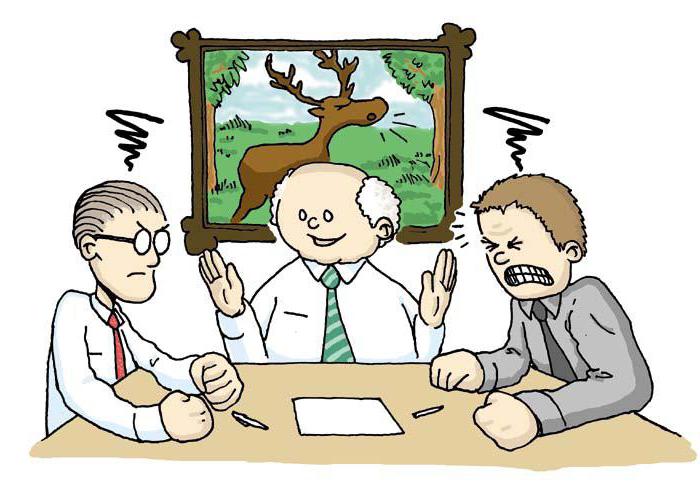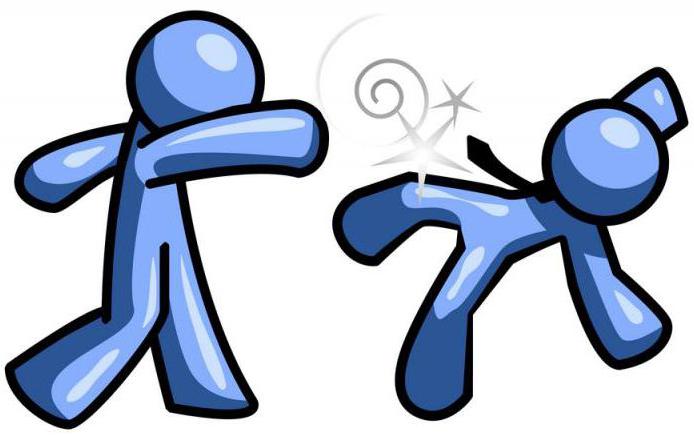The classification of conflicts is quite extensive, because certain contradictions can arise in a variety of teams and situations. In addition, their nature plays a huge role in resolving disputes.
The nature and classification of conflicts
Most experts define conflict as a way of resolving various contradictions that are the result of disagreements, diverging interests, worldviews, and so on. Between the participants of this process, tension and negative emotions certainly arise.
Each of the parties to the conflict firmly defends its position, not wanting to make concessions or reconsider its opinion. In this case, an indispensable condition is the incompatibility of the points of view of the parties or their complete contradiction. It is also worth noting that such situations can occur not only between individuals, but also between their groups, as well as within the same person.
You can determine the presence of a conflict by its main features, namely:
- contrasting two points of view on the same issue;
- active opposition, accompanied by emotional stress;
- the presence of active actors that constantly support the conflict situation in the active phase.
It is worth noting that the variety of situations that cause a contradiction reflects the classification of types of conflict. It can be based on the following features:
- duration (protracted, short-term, one-time);
- volume (personal, local, global);
- source (false, subjective, objective);
- funds (violent, passive);
- form (internal, antagonistic, external);
- nature (spontaneous, intentional);
- by areas of life (family, ethnic, political, economic).
The concept and classification of conflicts are the subject of study of such a science as conflictology. Psychology, sociology, philosophy and other areas of knowledge are inextricably linked with it.

Types of Conflict
Psychologists have developed the following classification of conflict types:
- genuine - actually exists and is formed on the basis of real problems or around specific things;
- random - occurs spontaneously and is not thought out in advance (it can be resolved with lightning speed or develop into a serious problem);
- displaced - when during the conflict not the task that is on the surface is solved, but hidden or veiled issues;
- incorrect - when the conflict arose for no apparent reason due to misunderstanding or inattention of one of the parties;
- latent - exists in reality, but is not fully understood by individuals, because of which it does not go into open confrontation;
- false - has no objective reasons, but arises on the basis of emotional tension or personal hostility.
Each of the above types can be applied to one or another classification feature. They are found both in private or public, and in political and economic life.

Causes of Conflict
The emergence of a conflict situation is always preceded by some kind of impetus. It can provoke a clash of interests, which will further develop according to a certain scenario. The most common classification of causes of conflict is as follows:
- Objective reasons:
- distribution of material or other resources (each side seeks to obtain the greatest benefit, as a result of which a contradictory situation arises);
- intersection of tasks (when people perform certain functions that may touch or contradict each other);
- contradictory goals (people, groups or units that interact with each other, can set guidelines that may contradict each other);
- ways to achieve goals (individuals interacting within the same team may have different views on achieving results);
- violation of communications (as a result of improperly organized communications, contradictions and inaccuracies may arise).
- Socio-psychological reasons:
- unfavorable psychological situation (in teams with an unfriendly atmosphere and poor organization, conflict situations often arise);
- adaptation of new team members (disputes may arise due to the rejection of the individual or because of his inappropriate behavior);
- social norms (compliance or non-compliance with their personalities interacting in the same team, as well as their different understanding);
- generational difference (a conflict arises from the mismatch or juxtaposition of values inherent in people of different ages);
- territoriality (disagreement between the inhabitants of different territories due to the mismatch of foundations and orders);
- destructive leader (pursuing his personal goals, brings discord to the work of the team);
- respondent aggression (an individual, faced with troubles or difficulties, expresses his discontent and aggression on others).
- Personal reasons:
- cognitive processes (in the course of life and the perception of information in people, a different assessment of certain situations may form);
- character traits (by virtue of his upbringing and worldview, as well as his psychological state, an individual may come into conflict with others).
Knowing the main reasons that lead to conflict situations, it is possible to take timely appropriate measures to prevent or eliminate them.

Conflict Functions
Every year, the classification of conflicts is becoming wider. Conflict Functions can be both positive and negative. The first include the following:
- during the conflict, the problem may be resolved or the contradiction between the parties may dry out;
- in the process of confrontation, hidden personality traits may appear that were previously unknown to others;
- due to the fact that negative emotions are given a way out, further tension is weakened;
- conflict is a kind of step to a new stage of interpersonal relations;
- in the event that the individual defends public opinion in the course of the confrontation, his authority can significantly increase;
- for an individual, participation in a conflict can be useful in terms of finding one's place in society, as well as self-realization.
The classification of conflicts shows us their prevalence, as well as inevitability. But, unfortunately, among their functions there are also negative ones:
- the creation of psychological stress in the team;
- high risk of violence during exacerbation of the contradiction;
- stressful situations negatively affect the state of health;
- as a result of the conflict, strong interpersonal and other ties can be destroyed;
- decrease in the effectiveness of collective and individual work;
- a habit of quarrels and violence is developed.
It can be concluded that the conflict cannot be regarded as an exclusively negative or extremely positive phenomenon. This is a rather multifaceted situation, which, with proper management, can be translated into a constructive direction.

Classification of Social Conflicts
Social conflict arises as a result of disagreements between individuals living or carrying out their activities within certain social frameworks. The reason may be a divergence of interests, the opposite goal setting and the incompatibility of beliefs and values. The classification of social conflicts is as follows:
- According to the number of participants:
- intrapersonal - arise when an individual faces a dilemma regarding making an important decision;
- interpersonal - a clash of interests of several people;
- intergroup - mismatch of points of view on certain issues among several groups.
- In accordance with the focus:
- horizontal - between people from the same social or professional stratum;
- vertical - contradictions between subordinates and superior (social classes may also be involved);
- mixed.
- According to the source:
- objective - they have specific causes that are obvious or easily established;
- subjective - due to the characteristics of the character or worldview of the warring parties.
- In accordance with the functions:
- constructive - in the process of resolving the conflict it becomes possible to make a constructive decision;
- destructive - introduce disagreements and destroy the existing system.
- In accordance with the content:
- rational - arise around specific subjects or issues;
- emotional - have an exclusively personal meaning.
- According to the duration:
- short-term - quickly resolved;
- long-term - do not fade over a long period of time.
- In accordance with the means of permission:
- peaceful;
- armed.
- In accordance with the nature:
- provoked intentionally to raise a particular problem;
- arising spontaneously.
- In accordance with the environmental impact:
- progressive - bring something new to the development of society;
- regressive - return the situation to its previous position.
- In accordance with the areas of life:
- political;
- economic;
- Ethnic
- household.
The category of social conflicts is one of the most important for study, because it permeates all spheres of human life. In addition, these situations can be projected to more serious problems to develop similar solutions to them.

Interpersonal conflicts
By interpersonal conflict is meant a clash of individuals that arose as a result of various disagreements. The stumbling block in this case may be the opposite of interests, goals or perception of the world. The classification of interpersonal conflicts is as follows:
- Towards:
- horizontal conflicts - arise between people of the same status who are not connected by subordination relationships;
- vertical - can develop between individuals due to class or service inequality.
- By appointment:
- constructive - lead to the development of rational decisions;
- destructive - lead to the destruction of established relationships.
- By field:
- business - arise in the process of professional activity exclusively around business issues;
- personal - based on the hostility of individuals towards each other or at the intersection of their own interests and goals.
- In the form of manifestation:
- hidden - tensions remain, but there is no obvious confrontation between the conflicting parties;
- open - entry into active opposition.
- By time:
- episodic - occur suddenly and resolve quickly enough;
- long - do not stop for a certain period (they can flow into the open or hidden phase).
The classification of interpersonal conflicts can be considered both independently and in interaction and intersection with other varieties.

Armed conflicts
Armed conflict, as its name implies, is a confrontation with the use of weapons of one kind or another. They can be of different directions, localization, and also have other differences.The classification of armed conflicts can be represented as follows:
- In accordance with the objectives:
- fair (when the feasibility of using weapons is recognized by international organizations);
- unjust (when a weapon is an unnecessary and unjustified measure).
- By territory:
- local (pass strictly within the boundaries of a certain territory);
- regional (affecting a large territory and can often result from local clashes);
- global (in them, as a rule, several states are involved, thus solving their territorial or resource and political disputes).
Armed conflicts are primarily in need of forecasting, which will allow timely adoption of certain decisions on their prevention or elimination.
Organization Conflicts
The labor collective is perhaps the most favorable environment for the emergence of disputes and disagreements. The classification of conflicts in the organization is as follows:
- confrontation levels can be horizontal, vertical or mixed;
- in accordance with the sphere of origin, they can have both a business and a personal character (they can also combine these two features);
- by the degree of manifestation, conflicts can be either hidden or explicit, having real manifestation (the second option is more preferable, since it accelerates the resolution of the situation);
- based on the nature, it is possible to distinguish both objective (having a real reason) conflicts and subjective conflicts based solely on individual views;
- conflicts can be constructive and destructive in accordance with the consequences.
Conflict Management
An integral part of modern reality is such a thing as conflict. Classifications of conflicts, conflict management are an objective necessity. This will keep them under control and effectively resolve. The individual has the ability to directly influence the dynamics and course of the confrontation.
The goal of conflict management is to turn a destructive conflict into a constructive channel or to prevent a constructive confrontation from becoming destructive. It is also worth noting the need to anticipate such situations in order to prevent them. In some cases, disputes can be artificially provoked to solve certain organizational problems or relieve hidden tensions in the team. The classification of conflicts in this case must be taken into account.
Conflict management includes a number of concepts:
- settlement - the search for an alternative due to which the interests of all warring parties will be satisfied to one degree or another, and the tension will be partially or completely relieved;
- resolution is the complete elimination of the cause of the conflict situation or the search for a compromise that will make it irrelevant or insignificant;
- forecasting - the ability to predict the occurrence of a contradictory situation on the basis of available data;
- warning - the adoption of a set of measures to prevent the development of conflict and its transition to an open form;
- stimulation - the creation of an atmosphere that would provoke a constructive confrontation or argument.
Classification of conflicts plays an important role in the management of disputes. Sometimes the choice of a set of measures may depend on this factor.

findings
The classification of modern conflicts shows us their diversity and multiplicity. These or other oppositions and conflicts of interests are found in almost all spheres of human life.This prompts scientists and psychologists to closely study conflict situations, because the dispute that arose between several individuals can be projected onto larger-scale confrontations. This allows you to develop effective methods of settlement and resolution. Conflict management can also include activities such as forecasting and anticipation, prevention and intentional incentives.
The basic classifications of conflicts affect the most important areas of human life. The most important role is played by interpersonal confrontations, which are found almost everywhere. Entering into labor activity, a person will certainly encounter organizational conflicts. Inter-regional and interstate confrontations are more global in importance, which can develop into the armed phase if measures to resolve them are not taken in time.
